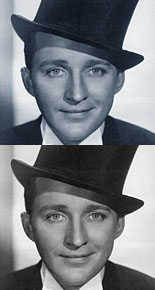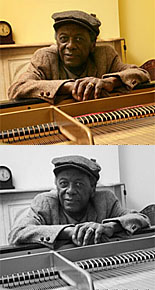Home » Jazz Articles » Old, New, Borrowed and Blue » Four In One: Monk From Four Different Angles
Four In One: Monk From Four Different Angles

While each of these items represents different things to the bride, they also have strong connection to jazz. The Old represents the past—traditions and the giants of jazz that have laid the groundwork for everything that has followed. New often refers to the artists that are toiling away—practicing and creating lasting art today that will, no doubt, be appreciated in the future. The Borrowed part of the saying touches on jazz in many ways. What jazz musician hasn't borrowed a lick from another, taken technical aspects from other players and used them in their own way, borrowed a chord progression to create a new song or even borrowed a song, for personal interpretation, from a different part of the world or genre of music? This brings us to Blue. This word...the color...the aura...and the sound are all at the heart of jazz. Whether we speak directly of the blues and its relationship—historically and currently—to jazz, or we view this color and mood in a broader sense, we still know that it underscores much of what jazz is all about.
For these reasons and to keep the luck and the love coming its way, jazz must continue to wear something old, something new, something borrowed and something blue.
While looking for a theme or idea for the first Old, New, Borrowed and Blue column, I was immediately drawn to pianist Thelonious Monk. His work has been front and center lately, due in no small part to Robin D. G. Kelley's biography, Thelonious Monk: The Life and Times of an American Original (Free Press, 2009). This book gets to the core of who Monk was; gives a detailed account of his performing career and family life; chronicles his professional and financial difficulties; and clears up many misconceptions about the man and his music. While reading this book, I couldn't help but think about my encounters with Monk's music and, ultimately, how he is the perfect figure to truly represent this column's four-pronged discussions.
Old
Monk's famed Town Hall Concert of February, 1959, has received a lot of attention over the past few years. Concord Records reissued this concert—The Thelonious Monk Orchestra at Town Hall —as part of the Keepnews Collection in 2007, the year Monk would have turned 90 had he still been alive. That same year, pianist Jason Moran dove into material from the concert for a celebration of Monk's ninetieth birthday year at Duke University, and came to Town Hall in late February, 2009 to celebrate the fiftieth anniversary of this historic performance. Bret Primack, better known as The Jazz Video Guy, put together a two-part video interview with producer Orrin Keepnews, discussing his memories of this concert. Add to all of this the detailed information that Kelley provides in his book and it's nearly impossible not to be astounded at the attention that's been paid to a one-off concert recording that took place half a century ago...except for the fact that it's much more than a one-off concert. While the stories have become part-legend at this point, they are still worth recounting.
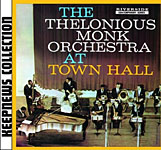 The idea was simple: Jules Colomby and promoter Marc Smilow would produce a concert of Monk's music for a large ensemble and Riverside would record it. Hall Overton was chosen as the man to orchestrate Monk's music for a large group, and so it began.
The idea was simple: Jules Colomby and promoter Marc Smilow would produce a concert of Monk's music for a large ensemble and Riverside would record it. Hall Overton was chosen as the man to orchestrate Monk's music for a large group, and so it began.Overton and Monk spent hours and hours seated at two pianos as Monk painstakingly taught his music, bit by bit, to Overton. The two men would then flesh out ideas for how to write this music for a ten-piece band. The music came together, little by little, a band was chosen and rehearsals were set up. While ample rehearsal time was set up for this concert, Kelley's research showed that the musicians were still struggling with this difficult material. According to Keepnews, trumpeter Donald Byrd had some potential conflicts with rehearsals, but Monk insisted that he would get Lee Morgan to do it if Byrd could not. This supposedly got the message across and Byrd made all of the rehearsals.
Many of these stories have been told for years, though some are only coming to light in great detail in Kelley's book. Regardless, it's important to remember that nobody would care about the stories if the music wasn't so special. Each piece provides a glimpse into Monk's world and, thankfully, the recording is here for the ages. Listening to Monk's solo on "Thelonious," it's clear that he practiced what he preached when talking about the need to know the melody when soloing. The wonderfully layered entrances on "Friday The 13th" introduce music that seems to spontaneously regenerate, like a worm re-growing after being cut in half, and the saxophone work is marvelous.
 Warm, deep brass envelops "Monk's Mood," while the band is simply on fire for "Little Rootie Tootie." This has long been acknowledged as the highlight of the concert, with Overton and Monk orchestrating the pianist's recorded solo for the band. The list of highlights goes on and on: Byrd's solo on "Off Minor," with Art Taylor swinging like mad beneath him; saxophonist Charlie Rouse's energized performance on "In Walked Bud"; and the quartet's rapport on "Rhythm-A-Ning." While naysayers at the time might have said the band was too bottom heavy, this blend is widely valued in jazz today. While a fifty-year span certainly marks this music as old, its modern sensibilities and sound continue to make it hip and timeless.
Warm, deep brass envelops "Monk's Mood," while the band is simply on fire for "Little Rootie Tootie." This has long been acknowledged as the highlight of the concert, with Overton and Monk orchestrating the pianist's recorded solo for the band. The list of highlights goes on and on: Byrd's solo on "Off Minor," with Art Taylor swinging like mad beneath him; saxophonist Charlie Rouse's energized performance on "In Walked Bud"; and the quartet's rapport on "Rhythm-A-Ning." While naysayers at the time might have said the band was too bottom heavy, this blend is widely valued in jazz today. While a fifty-year span certainly marks this music as old, its modern sensibilities and sound continue to make it hip and timeless. New
Monk's music has always appealed to others, even going back to the days when his "52nd Street Theme" was being performed all over that famed street; but some instruments never seemed to be likely candidates for the role of interpreting his tunes. The guitar is high up on this list. While plenty of guitarists have the facility and technique to play these songs, the nature and layout of the instrument makes it an odd choice. Monk himself, discounting any jam sessions with Charlie Christian or a guitarist in a large group, didn't use the instrument in his bands.
Ultimately, it's important to remember that the piano is a percussion instrument and Monk knew when to tread lightly and when to bring out the percussive force—both in his own compositions and those he interpreted. Keeping this in mind, it's astounding to consider that two distinctly different guitarists have put together incredible collections of Monk interpretations, releasing them within months of each other. While Bobby Broom's album, Plays for Monk (Origin, 2009), is a fine collection, Peter Bernstein's Monk (Xanadu, 2008) is specifically worthy of attention.
Bernstein, along with drummer Bill Stewart and bassist Doug Weiss, combed through the Monk catalog, came up with a dozen tunes and the results are stunning. A few things need to be kept in mind, however. First, the delicacy and cleanliness in the sound might turn some Monk fans off. Bernstein has an incredibly clean and articulate sound and touch—and it's a guitar, not a piano. It's essential to keep this in consideration and live with the concept before listening to the disc. Next, don't forget that Monk often had no choice but to play on out-of-tune instruments provided for shows or recordings, and that recording technology has evolved over the years. Last, this isn't mere imitation; it's interpretation.
 Bernstein's taste and technique serve this music well and he is largely loyal to the songs' melodies and musical attributes. "Let's Cool One" isn't covered as often as other Monk material so it's nice to hear that one start the album. Bernstein's solo work doesn't rely on Monk's sound too much here, but he and Stewart have fun trading back and forth, the two musicians continuing to trade solos throughout a large portion of the disc. "Pannonica" doesn't have celeste on it (as the original did), but seems to lean more toward Monk's sound than the album opener. "Work" doesn't necessarily set off any fireworks, but the band finally takes off and never looks back with "Brilliant Corners."
Bernstein's taste and technique serve this music well and he is largely loyal to the songs' melodies and musical attributes. "Let's Cool One" isn't covered as often as other Monk material so it's nice to hear that one start the album. Bernstein's solo work doesn't rely on Monk's sound too much here, but he and Stewart have fun trading back and forth, the two musicians continuing to trade solos throughout a large portion of the disc. "Pannonica" doesn't have celeste on it (as the original did), but seems to lean more toward Monk's sound than the album opener. "Work" doesn't necessarily set off any fireworks, but the band finally takes off and never looks back with "Brilliant Corners."Bernstein's two solo guitar takes—"Monk's Mood" and "Ruby My Dear"—get to the heart of the matter. Forceful, measured dissonant chords are mixed with broken arpeggiated lines and more gentle chords—a true approximation of what Monk's piano language and style should sound like on a guitar. "Reflections," with Bernstein overdubbing himself, shows another side of his playing, while the trio's interpretation of "Well, You Needn't," in 5/4, is worth the price of admission. Most Monk fans will nod their heads in approval when they hear what Bernstein has done with the iconic pianist's music.
Borrowed
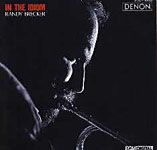 While Bernstein borrowing Monk's music to create something new is an overt use of this ideal, trumpeter Randy Brecker has created a tribute of sorts to both Thelonious Monk and Charles Mingus in the same tune by borrowing their very essence. Brecker's return to acoustic jazz in the mid-to-late 1980s on In The Idiom (Denon, 1987) yielded one of his most enduring tunes. I had the pleasure of hearing him perform "There's A Mingus A Monk Us" at Dizzy's Club Coca-Cola several years back and the way he weaved in subtle tributes to these two giants can't help but make you smile.
While Bernstein borrowing Monk's music to create something new is an overt use of this ideal, trumpeter Randy Brecker has created a tribute of sorts to both Thelonious Monk and Charles Mingus in the same tune by borrowing their very essence. Brecker's return to acoustic jazz in the mid-to-late 1980s on In The Idiom (Denon, 1987) yielded one of his most enduring tunes. I had the pleasure of hearing him perform "There's A Mingus A Monk Us" at Dizzy's Club Coca-Cola several years back and the way he weaved in subtle tributes to these two giants can't help but make you smile.Brecker played this song with his group when he appeared on Marian McPartland's Piano Jazz radio program, with pianist Bill Charlap as guest host, and it is available to hear on the National Public Radio (NPR) website. Brecker's connection to Mingus is far more direct than his connection to Monk, however, playing with the bass legend towards the end of his life. The trumpeter has also been part of many Mingus projects over the years. Even the key signature of his tune—D-flat—is a nod toward the bassist because he enjoyed writing in this key.
Borrowing these ideals helped Brecker create a piece of music that sounds fresh but is tied into what came before him. The Monk-isms, including some angular lines and punchy rhythmic statements, are essential in helping to make this music moving and powerful. While this is only one piece in Brecker's impressive collection of songs, it certainly shows his fondness for borrowing ideas and compositional attributes from other musicians.
Blue
When thinking about Monk and the word blue, is it any wonder that "Blue Monk" is the first song that comes to mind? While sifting through recordings and score samples on the web, looking for music to use with my middle school jazz band, I came upon an arrangement of "Blue Monk." Monk-for-middle-school? Absolutely. It sounds hip, appears to be well put together, and begs the question: what would Thelonious Monk think about his music being interpreted by kids in school jazz bands in 2010?
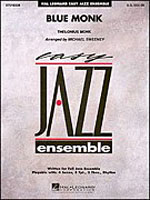 On one hand, he would likely love it, and his role in educating musicians to learn his songs would be expanded to the furthest reaches. On the other, there might be some bitterness. This man and musical genius had great difficulty getting his own music recorded at first, and struggled to get jobs during his own prime. I think that the irony of his fame increasing ten-fold after his death wouldn't be lost on Monk. Regardless of what he might have thought, I am thankful that his music is here for students to hear and learn. Kelley's book notes that "Blue Monk" was written in the studio in 1954, when Bob Weinstock "complained that Monk never played the blues." Kelley mentions that Monk later cited this as one of his favorite pieces and, thankfully, many recordings of Monk playing this song exist today. Next year, I hope to include this one in a program, along with "Blue and Sentimental" and "Blue Bossa," that brings The Blues, in color and sound, into focus for my middle school jazz band.
On one hand, he would likely love it, and his role in educating musicians to learn his songs would be expanded to the furthest reaches. On the other, there might be some bitterness. This man and musical genius had great difficulty getting his own music recorded at first, and struggled to get jobs during his own prime. I think that the irony of his fame increasing ten-fold after his death wouldn't be lost on Monk. Regardless of what he might have thought, I am thankful that his music is here for students to hear and learn. Kelley's book notes that "Blue Monk" was written in the studio in 1954, when Bob Weinstock "complained that Monk never played the blues." Kelley mentions that Monk later cited this as one of his favorite pieces and, thankfully, many recordings of Monk playing this song exist today. Next year, I hope to include this one in a program, along with "Blue and Sentimental" and "Blue Bossa," that brings The Blues, in color and sound, into focus for my middle school jazz band.Stay tuned for more Old, New, Borrowed and Blue.
< Previous
The French Connection
Next >
Bombella
Comments
Tags
Thelonious Monk
Old, New, Borrowed and Blue
Dan Bilawsky
United States
jason moran
Hall Overton
Donald Byrd
lee morgan
Art Taylor
Charlie Rouse
Charlie Christian
Bobby Broom
Peter Bernstein
Bill Stewart
randy brecker
Charles Mingus
Marian McPartland
Bill Charlap
For the Love of Jazz
 All About Jazz has been a pillar of jazz since 1995, championing it as an art form and, more importantly, supporting the musicians who create it. Our enduring commitment has made "AAJ" one of the most culturally important websites of its kind, read by hundreds of thousands of fans, musicians and industry figures every month.
All About Jazz has been a pillar of jazz since 1995, championing it as an art form and, more importantly, supporting the musicians who create it. Our enduring commitment has made "AAJ" one of the most culturally important websites of its kind, read by hundreds of thousands of fans, musicians and industry figures every month.






